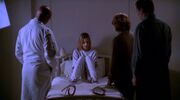- ↳ Note: This article is about the illusory version. For other uses, see Buffy.
- “No, none of that's real, none of it. You're in a mental institution. You've been with us now for six years. Do you remember?”
- ―Dr. Berris[src]
Buffy Summers was an illusory version of the original Buffy, stuck in a world where she was instead in a mental hospital as a patient with schizophrenia.[1]
Biography[]
- “Buffy's delusions are multi-layered. She believes she's some type of hero.”
- ―Dr. Berris[src]
Buffy had a glimpse of this magically constructed illusion when she was stabbed by a skewer from a Glarghk Guhl Kashmas'nik demon, summoned by the Trio against her. The injected venom gave her recurring visions of her treatment, suggesting that her six years as the Slayer in Sunnydale were just hallucinations part of her delusion.[1]
According to this world, Buffy had been a patient in an inpatient mental health facility for the previous six years, when she was diagnosed with a form of schizophrenia after claiming to see vampires. Her mother Joyce was still alive and still married to Buffy's father Hank.[1]

Buffy with her doctor and parents.
Her time in heaven after her death was explained as her having a temporary recovery from her condition the previous summer. Her doctor, Raymond Berris, theorized that Dawn's sudden creation was the result of Buffy needing a familial bond after Joyce's death within her delusion, but that the fantasy world Buffy had created was then no longer as satisfying to her as it once was, hence the inadequacy of the Trio compared to previous villains and her visions of the reality of the asylum.[1]
Joyce pleaded with Buffy to find the strength and in her heart to accept the reality and reject the fantasy. In the end, Buffy chose the tougher path of bearing the burden of being the Slayer, and she lapsed back into a catatonic state, much to her parents' distress.[1]
Behind the scenes[]
- She was portrayed by Sarah Michelle Gellar.
- In his audio commentaries for "Normal Again," the director Rick Rosenthal said that the episode's ending is intentionally ambiguous, leaving it to the viewer to decide whether it was real or not.
- On the theory that "Normal Again" revealed Buffy's actual world, Joss Whedon commented: "How important it is in the scheme of the Buffy narrative is really up to the person watching. If they decide that the entire thing is all playing out in some crazy person's head, well, the joke of the thing to us was it is, and that crazy person is me. It was kind of the ultimate postmodern look at the concept of a writer writing a show, which is not the sort of thing we usually do on the show. The show had merit in itself because it did raise the question, 'How can you live in this world and be sane?'. But at the same time the idea amused me very much and we played on it a little bit, 'How come her little sister is taller than her?', 'What was Adam's plan?'. We played on the crazy things we came up with time and time again, to make this fantasy show work and called them into question the way any normal person would. But ultimately the entire series takes place in the mind of a lunatic locked up somewhere in Los Angeles, if that's what the viewer wants. Personally, I think it really happened."[2]
- Marti Noxon, in turn, was more direct in denying this theory: "It was a fake out; we were having some fun with the audience. I don't want to denigrate what the whole show has meant. If Buffy's not empowered then what are we saying? If Buffy's crazy, then there is no girl power; it's all fantasy. And really the whole show stands for the opposite of that, which is that it isn't just a fantasy. There should be girls that can kick ass. So I'd be really sad if we made that statement at the end. That's why it's just somewhere in the middle saying 'Wouldn't it be funny if...?' or 'Wouldn't this be sad or tragic if...?' In my feeling, and I believe in Joss' as well that's not the reality of the show. It was just a tease and a trick."[3]
- Similarly, in 2011, Gellar guest starred on her former soap opera All My Children as a well dressed, coiffured, and otherwise coherent young woman who had been brought in for psychiatric evaluation for claiming to see vampires.
- At ComicCon 2013, while speaking about this episode, Whedon mentioned that, during his time writing Astonishing X-Men, he envisioned Cyclops, whose real name is Scott Summers, making a reference to a female cousin of his who had been sent to a mental institution for believing she was a demon hunter. However, he could not find an appropriate place in the storyline to fit it in, and therefore it was never featured.[4]
Appearances[]
- "Normal Again" (Only in visions)
References[]
- ↑ 1.0 1.1 1.2 1.3 1.4 "Normal Again"
- ↑ "10 Questions for Joss Whedon." The New York Times, May 16, 2003.
- ↑ Edward Gross, Mark A. Altman, Slayers & Vampires. Pan Macmillan, 2017.
- ↑ Eric Eisenberg, "10 Things I Learned About Joss Whedon At Comic Con 2013." Cinemablend, August 8, 2013.
